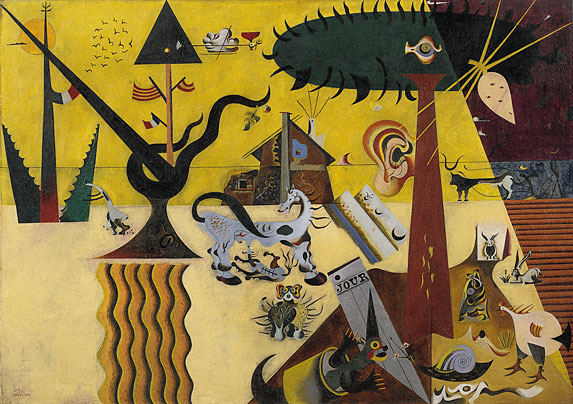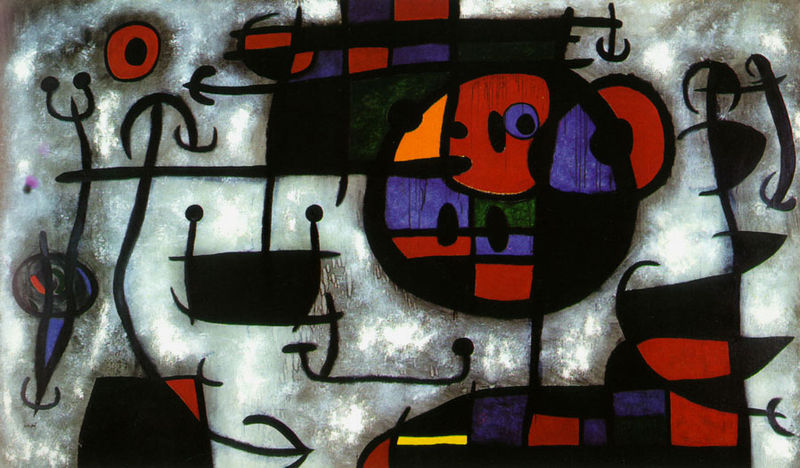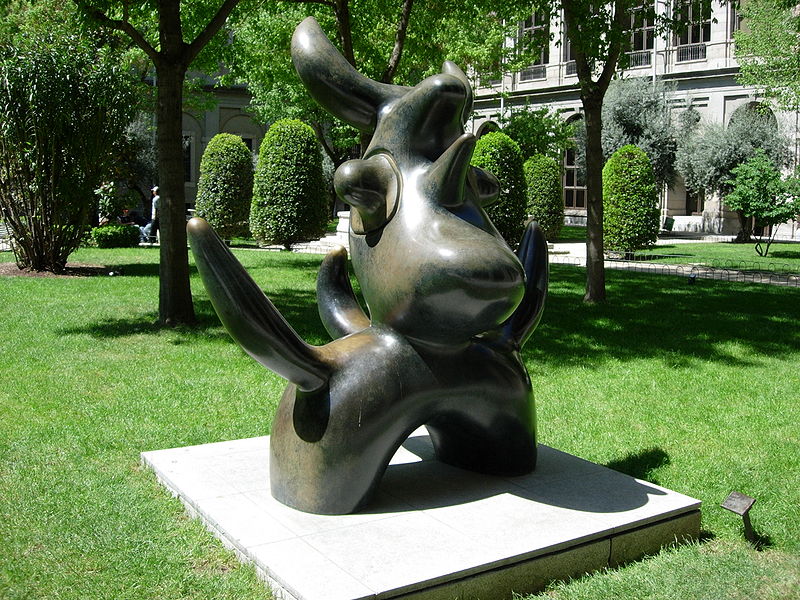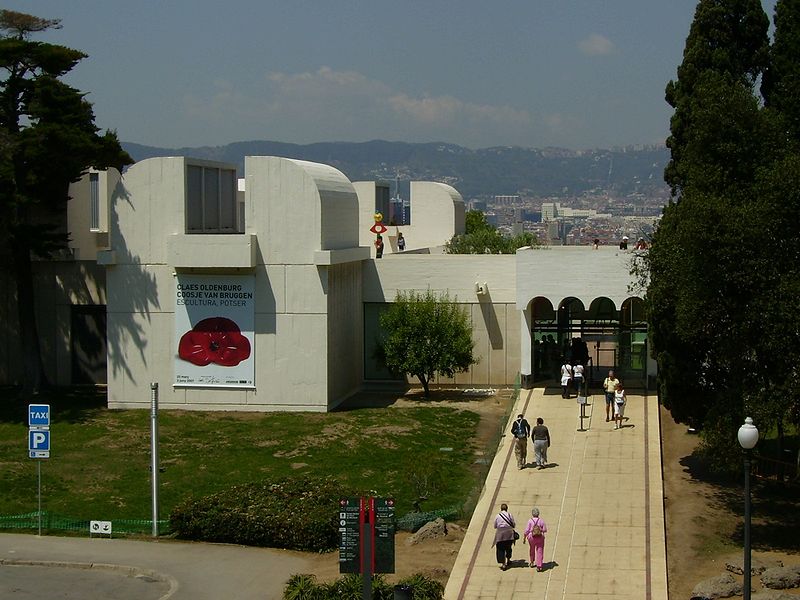<Back to Index>
- Physician Philippe Pinel, 1745
- Painter and Sculptor Joan Miró i Ferrà, 1893
- Emperor of France Napoléon III, 1808
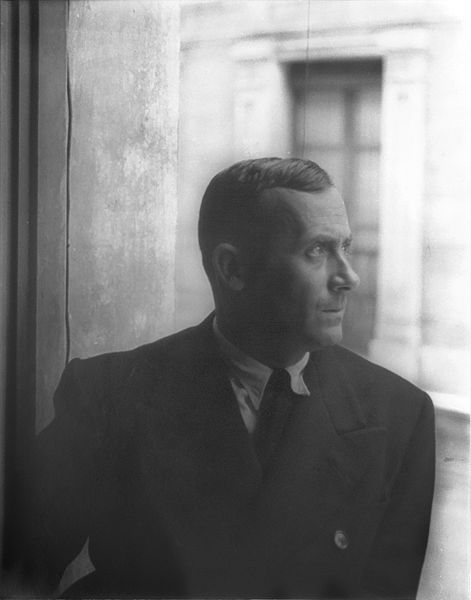
Joan Miró i Ferrà (April 20, 1893 – December 25, 1983) was a Spanish Catalan painter, sculptor, and ceramist born in Barcelona.
Earning international acclaim, his work has been interpreted as Surrealism,
a sandbox for the subconscious mind, a re-creation of the childlike,
and a manifestation of Catalan pride. In numerous interviews dating
from the 1930s onwards, Miró expressed contempt for conventional painting methods as a way of supporting bourgeois society, and famously declared an "assassination of painting" in favor of upsetting the visual elements of established painting. Born to the families of a goldsmith and watchmaker, the young Miró was drawn towards the arts community that was gathering in Montparnasse and in 1920 moved to Paris. There, under the influence of the poets and writers, he developed his unique style: organic forms and flattened picture planes drawn with a sharp line. Generally thought of as a Surrealist because of his interest in automatism and
the use of sexual symbols (for example, ovoids with wavy lines
emanating from them), Miró’s style was influenced in varying
degrees by Surrealism and Dada, yet he rejected membership to any artistic movement in the interwar European years. André Breton,
the founder of Surrealism, described him as "the most Surrealist of us
all." Miró confessed to creating one of his most famous works, Harlequin's Carnival, under similar circumstances: Joan Miró was originally part of the Generation of '27, a collective made up of Spanish poets, writers, painters and film makers that included Luis Buñuel, Miguel Hernández, José María Hinojosa and García Lorca.
The latter three were murdered by Franco during Spain's fascist reign.
Buñuel and a few other artists were able to flee for France and
the US. Miró was among these exiles. It is also important to
note that Miró's surrealist origins evolved out of "repression"
much like all Spanish surrealist and majic realist work. Also, Joan
Miró was well aware of Haitian Voodoo art and Cuban Santería religion through his travels before going into exile. This led to his signature style of art making. In 1926, he collaborated with Max Ernst on designs for Sergei Diaghilev. With Miró's help, Ernst pioneered the technique of grattage, in which he troweled pigment onto his canvases. Miró married Pilar Juncosa in Palma de Mallorca on October 12, 1929; their daughter Dolores was born July 17, 1931. Shuzo Takiguchi published
the first monograph on Miró in 1940. In 1948–49, although living
in Barcelona, Miró made frequent visits to Paris to work on
printing his techniques at the Mourlot Studios (lithographs) and at the Atelier Lacourière (engravings). A close relationship lasting forty years developed with the printer Fernand Mourlot and resulted in the production of over one thousand different lithographic editions. In 1959, André Breton asked Miró to represent Spain in The Homage to Surrealism exhibition together with works by Enrique Tábara, Salvador Dalí, and Eugenio Granell. Miró created a series of sculptures and ceramics for the garden of the Maeght Foundation in Saint-Paul-de-Vence, France, which was completed in 1964. Miró was among the first artists to develop automatic drawing as a way to undo previous established techniques in painting, and thus, with André Masson, represented the beginning of Surrealism as
an art movement. However, Miró chose not to become an official
member of the Surrealists in order to be free to experiment with other
artistic styles without compromising his position within the group. He
pursued his own interests in the art world, ranging from automatic
drawing and surrealism, to expressionism and Color Field painting. Miró's oft-quoted interest in the assassination of painting is derived from a dislike of bourgeois art
of any kind, used as a way to promote propaganda and cultural identity
among the wealthy. Specifically, Miró responded to Cubism in this way, which by the time of his quote had become an established art form in France. He is quoted as saying "I will break their guitar," referring to Picasso's paintings, with the intent to attack the popularity and appropriation of Picasso's art by politics. In an interview with biographer Walter Erben, Miró expressed his dislike for art critics,
saying, they "are more concerned with being philosophers than anything
else. They form a preconceived opinion, then they look at the work of
art. Painting merely serves as a cloak in which to wrap their emaciated
philosophical systems." Four-dimensional
painting is a theoretical type of painting Miró proposed in
which painting would transcend its two-dimensionality and even the
three-dimensionality of sculpture. In
the final decades of his life Miró accelerated his work in
different media, producing hundreds of ceramics, including the Wall of the Moon and Wall of the Sun at the UNESCO building
in Paris. He also made temporary window paintings (on glass) for an
exhibit. In the last years of his life Miró wrote his most
radical and least known ideas, exploring the possibilities of gas sculpture and four-dimensional painting. In 1974, Miró created a tapestry for the World Trade Center in New York City. He had initially refused to do a tapestry, then he learned the craft and produced several ones. His World Trade Center Tapestry was displayed for many years at World Trade Center building. It was one of the most expensive works of art lost during the attack of the twin towers. In 1981, Miró's The Sun, the Moon and One Star — later renamed Miró's Chicago — was unveiled. This large, mixed media sculpture is situated outdoors in the downtown Loop area of Chicago, across the street from another large public sculpture, the Chicago Picasso. Miró had created a bronze model of The Sun, the Moon and One Star in 1967. The model now resides in the Milwaukee Art Museum. One of Miró’s most important works in the United States is his only glass mosaic mural, Personnage Oiseaux (Bird Characters), 1972–1978. Miró created it specifically for Wichita State University’s Edwin A. Ulrich Museum of Art, Kansas.
The mural is one of Miró’s largest two-dimensional projects,
undertaken when he was 79 and completed when he was 85 years of age. Fabrication
of the mural was actually completed in 1977, but Miró did not
consider it finished until the installation was complete. The
glass mosaic was the first for Miró. Although he wanted to do
others, time was against him and he was not able. He was to come to the
dedication of the mural in 1978, but he fell at his studio in Palma de Mallorca, Spain, and was unable to travel. His island home and studio in Mallorca served him from 1956 until his death in 1983.
The
entire south wall of the Ulrich Museum is the foundation for the
28 ft by 52 ft (8.53 m x 15.85 m) mural, composed of one
million pieces of marble and Venetian glass mounted on specially
treated wood, attached to the concrete wall on an aluminum grid. A gift
of the artist, donor groups paid for the fabrication by Ateliers Loire of Chartres, France, and for its installation. The Ulrich Museum also acquired the 5 ½ ft by 12 ft oil on canvas maquette for
the mural, but it has since been sold to establish a fund to support
the museum’s acquisitions and any repairs needed to the mural. The
entire mural was originally assembled by one artisan at Ateliers Loire
using Miró’s maquette as a guide. Fabricated
under Miró’s personal direction and completed in 1977, the 40
panels comprising the mural were shipped to WSU, and the mural was
installed on the Ulrich Museum’s façade in
1978. Although it has received little recognition, the mural is a
seminal work in the artist’s career, being one of Miró’s largest two-dimensional works in North America and the only type of its kind by the artist. Miró
worked on several illustrated books. These were known as "Livre
d'Artist." One such work was published in 1974, at the urging of the
widow of the French poet Robert Desnos titled
"Les pénalités de l'enfer ou les nouvelles
Hébrides" (The Penalties of Hell or The New Hebrides). It was a
set of 25 lithographs, five in black, and the others in colors. In
2006 the book was displayed in “Joan Miro, Illustrated Books” at the
Vero Beach Museum of Art. Miró received a doctorate honoris causa in 1979 from the University of Barcelona. He died bedridden at his home in Palma, Mallorca on December 25, 1983. He suffered from heart disease and had visited a clinic for respiratory problems two weeks before his death. Many of his pieces are exhibited today in the National Gallery of Art in Washington, DC and Fundació Joan Miró in Montjuïc, Barcelona;
his body is buried nearby, at the Montjuïc cemetery. Today,
Miró's paintings sell for between US$250,000 and US$17 million;
the latter was the auction price for the La Caresse des étoiles on May 6, 2008, and is the highest amount paid for one of his works. Joan Miró i Ferrà won several awards in his lifetime. In 1954 he was given the Venice Biennale print making prize, in 1958 the Guggenheim International Award, and in 1980 he received the Gold Medal of Fine Arts from King Juan Carlos of Spain. In 1981, the Palma de Mallorca City Council established the Fundació Pilar i Joan Miró a Mallorca, housed in the four studios that Miró had donated for the purpose.
